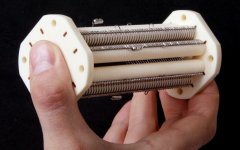Chemotherapy drugs react differently to radiation while in water (Vol. 50, No. 5-6)

A new study looked at the way certain molecules found in chemotherapy drugs react to radiation while in water, which is more similar to in the body, compared to previous research that studied them in gas.
Cancer treatment often involves a combination of chemotherapy and radiotherapy. Chemotherapy uses medication to stop cancer cells reproducing, but the medication affects the entire body. Radiotherapy uses radiation to kill the cancer cells, and it is targeted to the tumour site. In a recent study, published in the journal EPJD, the authors studied selected molecules of relevance in this context. They wanted to see how these molecules were individually affected by radiation similar to that used in radiotherapy.
S. E. Huber and A. Mauracher, Electron impact ionisation cross sections of fluoro-substituted nucleosides, Eur. Phys. J. D 73, 137 (2019)
[Article]
CHEP2018 Conference Proceedings (Vol. 51, No. 1)

The 23rd International Conference on Computing in High Energy and Nuclear Physics was held in the National Palace of Culture, Sofia, Bulgaria from 9th to 13th of July 2018. The program consisted of 27 plenary, 323 parallel presentations and 188 posters. The plenary talks covered topics such as HPC and cloud computing, machine learning in High Energy Physics (HEP), overviews of experiment software for data acquisition, high level triggering, reconstruction and analysis, experience from astro-particle and neutrino physics, as well as broader subjects like multithreading and vectorization in HEP, use of blockchains, quantum computing, software citation mechanisms. Progress on common and widely used tools and packages in HEP such as ROOT, EOS and CVMFS was also presented. A dedicated talk and a panel discussion were devoted to the implementation of a successful diversity program in the field of HEP and nuclear physics computing.
A. Forti, L. Betev, M. Litmaath, O. Smirnova and P. Hristov (Eds.),, 23rd International Conference on Computing in High Energy and Nuclear Physics (CHEP 2018), Sofia, Bulgaria, July 9-13 , 2018',, EPJ Web of Conferences 214 (2019)
[Proceedings]
Chimera states are fragile under random links (Vol. 51, No. 2)

In a chimera state of large interactive systems the underlying symmetry of the dynamical system is spontaneously broken and the spatial profile splits into synchronised and desynchronised groups.
In this work the surprising fragility of chimeras in the presence of very few time-varying random links is demonstrated in wide-ranging examples. Spatial randomness restores the symmetry of the emergent spatial patterns, with chimeras giving way to uniform steady states or spatiotemporal chaos. The size of the basin of attraction of chimeras rapidly shrinks under increasing randomness, indicating its strong impact on the global stability of chimeras. These results impact the search for chimeras in real-world systems.
Sudeshna Sinha, Chimera states are fragile under random links, EPL 128, 40004 (2019)
[Abstract]
Chip-Based Frequency Shift Super-Resolution Imaging (Vol. 50, No. 4)

Current label-free super-resolution methods suffer from either limited resolution improvements, small field-of-views or complex implementations, and a method with high-resolution, high-throughput and easy configuration is desirable for the practical applications in materials, biology and medicine, etc. To break this limitation, the authors propose a Si3N4 waveguide platform design for multi-wavelength illuminated label-free super-resolution microscopy imaging. The deep-subwavelength resolution was enabled by large wave-vector evanescent illumination induced spatial frequency shift effect, which also provides the high throughput for its wide field implementation.
In the method, chip-based waveguide with high refractive index produced evanescent wave illumination on the upper surface, the high tangential wave vector shifted the high spatial frequency components into the passband of the detection system from the perspective of the reciprocal domain. Multi-wavelength illuminated method was employed to cover the complete detection in the frequency domain. This enlarged the detectable broad-band frequency spectrum range, and high-resolution image with high signal-to-noise-ratio could be achieved using reconstruction algorithm. The optimized waveguide design to realize single mode behaviour and low attenuation guaranteed uniform evanescent wave illumination for the low-noise wide-field imaging. The integrated device is cost-effective, mass-producible and can conveniently give super resolvability to conventional microscopy as a compact module.
X. Xu, X. Liu, Ch. Pang, Y. Ma, Ch. Meng, J. Zhang, X. Liu and Q. Yang, Si3N4 waveguide platform for label-free super-resolution imaging: simulation and analysis, J. Phys. D: Appl. Phys. 52, 284002 (2019)
[Abstract]
Classical and quantum approaches to the photon mass (Vol. 42, No. 4)
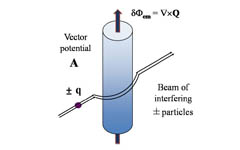 In new effects of the Aharonov-Bohm type, coherent superpositions of particles possessing opposite electromagnetic properties are used. For the one shown in this figure, charged particles interact with the magnetic vector potential A of a solenoid. If the photon mass is not zero, the electromagnetic interaction is modified. Measuring the corresponding change of quantum phase shift with an interferometer leads to an estimate of mγ.
In new effects of the Aharonov-Bohm type, coherent superpositions of particles possessing opposite electromagnetic properties are used. For the one shown in this figure, charged particles interact with the magnetic vector potential A of a solenoid. If the photon mass is not zero, the electromagnetic interaction is modified. Measuring the corresponding change of quantum phase shift with an interferometer leads to an estimate of mγ.
Since Proca's prediction in 1936 that the rest mass of the photon, mγ, may not be zero, there have been several searches for evidence for a possible finite photon mass. In fact, for even a very small value of mγ, fascinating physical implications arise such as breakdowns of Coulomb's law, wavelength dependence of the speed of light in free space, existence of longitudinal electromagnetic waves, presence of an additional Yukawa potential for magnetic dipole fields, and effects that a photon mass may have during early-universe inflation and the resulting magnetic fields on a cosmological scale.
Traditionally, limits on mγ of < 10-49g have been obtained by means of classical approaches, such as searches for departures from Coulomb's law. What happens if we instead exploit quantum approaches? Could better limits be achieved? This is the novel objective of the present work, in which quantum physics is applied to the photon mass question. We first examine the implications that the Aharonov-Bohm class of quantum effects (Figure) have on searches for mγ, and then move on to explore the quantum electrodynamics scenario with an approach that employs measurements of the electron's g-factor. Within the quantum framework, we show that competitive new lower limits on the photon mass may reach the range 10-54 < mγ < 10-53g. We provide an assessment of the state of the art in these areas and a prognosis for future work.
A survey of existing and proposed classical and quantum approaches to the photon mass
G. Spavieri, J. Quintero, G.T. Gillies and M. Rodriguez, Eur. Phys. J. D 61, 531 (2011)
[Abstract]
Clearer vision of the biochemical reaction that allows us to see (Vol. 49 No.5-6)
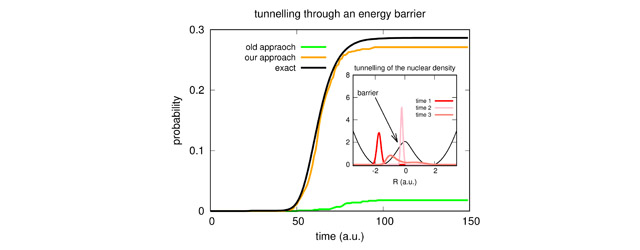
Physicists develop improved algorithms for simulating how complex molecules respond to excitation by photons, and explaining what happens when photons hit our eyes.
What makes it possible for our eyes to see? It stems from a reaction that occurs when photons come into contact with a protein in our eyes, called rhodopsin, which adsorbs the photons making up light. In a paper published recently the authors propose a refined approximation of the equation that describes the effect of this photo-excitation on the building blocks of molecules. Their findings also have implications for other molecules, such as azobenzene, a chemical used in dyes. The incoming photon triggers certain reactions, which can result, over time, in dramatic changes in the properties of the molecule itself. This study was included in a special anniversary issue of EPJB in honour of Hardy Gross.
F. Agostini, I.Tavernelli, and G. Ciccotti, Nuclear Quantum Effects in Electronic (Non)Adiabatic Dynamics, Eur. Phys. Jour. B 91, 139 (2018)
[Abstract]
Cocktail achieves superconducting boost (Vol. 44 No. 2)
 Superconductivity occurs at 44 K
Superconductivity occurs at 44 K
This paper describes how to synthesize a new material that belongs to the iron-selenide class of superconductors, called LixFe2Se2(NH3)y. This material displays promising superconducting transition temperatures around 44 K at ambient pressure, thus improving upon traditional copper-based high-temperature superconductors.
The ultimate goal in developing such materials is to reach superconducting characteristics at temperatures above that of liquid nitrogen (77 K) to make them attractive for applications. Until now, superconductors based on iron and arsenic, discovered in 2008, worked at 56 K. As recently as 2010 attempts to develop other materials replacing arsenic with selenium yielded iron-selenium materials with an intercalation of potassium, rubidium, caesium or thallium. These materials, belonging to the family of iron chalcogenide materials, reached a superconducting temperature of 32 K.
The authors have now used a chemical synthesis method to intercalate lithium atoms between layers of iron and selenium. Similar to the way a cocktail would generate an exciting new flavour, stirring all these ingredients for several hours in liquid ammonia produced exciting new superconducting properties. The properties are controlled by electronic doping and by expansion of the iron-selenium material’s lattice structure, which is gained by intercalating the lithium-based electronic donor molecules.
The authors showed that these materials can be synthesised with a remarkable degree of purity. And the fraction of the material that is superconductive is almost 80%, the highest reported for materials in this family.
E.-W. Scheidt, V.R. Hathwar, D. Schmitz, A. Dunbar, W. Scherer, F. Mayr, V. Tsurkan, J. Deisenhofer, and A. Loidl, ‘Superconductivity at Tc = 44 K in LixFe2Se2(NH3)y’, Eur. Phys. J. B 85, 279 (2012)
[Abstract]
Coherent investigation of nuclear data at CEA DAM: a review (Vol. 43 No. 6)
 Jezebel (a plutonium sphere) reactivity induced by components of the evaluated BRC09 and ENDF/B-VII.0 239Pu file, demonstrates that two different evaluated data sets predict the same Keff criticality for different underlying reasons; one or more of them (probably both) are in need of improvements.
Jezebel (a plutonium sphere) reactivity induced by components of the evaluated BRC09 and ENDF/B-VII.0 239Pu file, demonstrates that two different evaluated data sets predict the same Keff criticality for different underlying reasons; one or more of them (probably both) are in need of improvements.
A body of work accomplished by the CEA/DAM is reviewed to determine accurate nuclear reaction cross sections for use in neutron transport codes. This work integrates theory and modeling, experiment, computer simulation, and statistical analysis. It involves researchers who thrive on multidisciplinary work, and who are motivated to achieve realistic simulation predictions in nuclear technology applications. Not only has the group succeeded in creating databases of accurate cross sections, but, in every aspect of the work, significant progress has been made in the understanding of the underlying nuclear physics.
This unique analysis of advances in applied nuclear reaction physics, includes, notably: (1) Fission and inelastic scattering using detailed nuclear structure descriptions of actinides; (2) Integral simulations of critical assemblies that reveal compensating errors between different reaction channels (Fig) – this CEA discovery is now motivating the broader community to identify and eliminate deficiencies; (3) Identification of limitations on the applicability of the surrogate method for neutron capture.
CEA/DAM contributes to the Joint Evaluated Fusion and Fission File (JEFF3.1), the database that is used widely in European nuclear technologies. It collaborates closely with related efforts in the USA (ENDF/B-VII) and Japan (JENDL). The authors show useful comparisons of their work against those based on ENDF/B-VII.0 and JENDL3.3-08, demonstrating the quality of these various capabilities. CEA/DAM strengths lie, in particular, in bringing microscopic theoretical insights in fission, coupled-channel optical model, and inelastic scattering to advance the quality of their application nuclear databases.
E. Bauge + 28 co-authors, ‘Coherent investigation of nuclear data at CEA DAM: Theoretical models, experiments and evaluated data’, Eur. Phys. J. A 48, 113 (2012)
[Abstract]
Cold Fusion Mechanism in Nanoscale Catalysis? (Vol. 41, No. 6)
The well-understood mechanism of muon-catalyzed nuclear fusion is used for a fundamental understanding of H2O2 catalysis by nanogold, including the substantial enhancement by Au-Pd. Consider the muon-catalyzed fusion using t and d. At the Ramsauer-Townsend (R-T) minimum of the dµ and tµ elastic scattering, dtµ molecules form through strong resonances. The Coulomb barrier shrinks and d-t fusion results. In gold catalyzed H2O2 the Au- anion is first formed at the R-T minimum of the electron-Au elastic cross section. Single and double water molecules can attach to the Au- anion through strong resonances with large rates forming Au-(H2O)1 and Au-(H2O)2 anion-molecule complexes. The Coulomb barrier shrinks. Because the experiment used nanogold supported on Fe2O3, a chemical reaction between H2O and O2 resulted in H2O2 formation, releasing the Au- catalyst.
A similar analysis applies to the electron-Pd elastic scattering but with the caveat that the Pd electron affinity is slightly smaller than and R-T minimum is deeper than and extends beyond that of gold. Hence, this rich environment in minima and resonances facilitates attachment of water molecules to Au- and Pd- anions, yielding H2O2 through multiplicative catalyses.
Electron-electron correlations and core-polarization interactions are crucial for the existence and stability of most negative ions. These physical effects are embedded in our calculations. Indeed, atomic negative ions play an essential role in cold nuclear fusion and in catalysis, a chemical reaction. Au, Pt, Pd and Y atoms can be used in various combinations.
This discovery ushers in new frontiers of efficient design and synthesis of novel functional compounds and catalysts for various chemical reactions, impacting many industries. The controversial Fleischmann–Pons "cold fusion" experiment can now be understood. It used Pt-Pd electrodes and has generated attention in recent APS NEWS articles.
Novel mechanism for nanoscale catalysis
A.Z. Msezane, Z. Felfli and D. Sokolovski, J. Phys. B: At. Mol. Opt. Phys., 43, 201001 (2010)
[Abstract]
Collagen fibres grow like a sunflower (Vol. 50, No. 4)

Collagen fibrils are a major component of the connective tissues found throughout the animal kingdom. The cable-like assemblies of long biological molecules combine to form tissues as varied as skin, corneas, tendons or bones. The development of these complex tissues is the subject of a variety of research efforts, focusing on the steps involved and the respective contributions of genetics and physical chemistry to their development. Now, the authors have shed new light on how complex collagen fibrils form. In a new study published recently, they focus on one of the hierarchical steps, in which molecules spontaneously associate in long and dense axisymmetric fibres, known as type I collagen fibrils. In this study, the spontaneous association step under scrutiny is unique because the diameter of the fibre remains constant throughout its growth, while the end of growth manifests a characteristic parabolic profile. After studying several possible models, the researchers concluded the most likely explanation is that the fibres spread out from the fibre axis, along a stem, similar to how a sunflower’s florets grow.
J. Charvolin, and J-F. Sadoc, Type I collagen fibrils: from growth morphology to local order, Eur. Phys. J. E 42, 49 (2019)
[Abstract]
Combining experimental data to test models of new physics that explain dark matter (Vol. 49, No. 1)
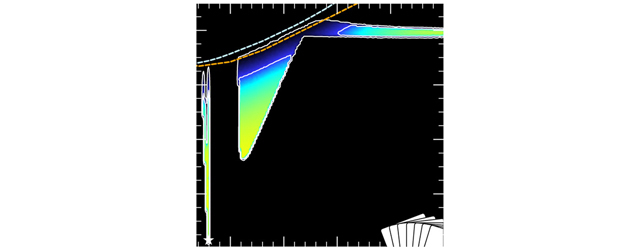
The most statistically consistent and versatile tool to date is designed to gain insights into dark matter from models that extend the standard model of particle physics, rigorously comparing them with the latest experimental data.
In chess, a gambit refers to a move in which a player risks one piece to gain an advantage. The quest to explain dark matter, a missing ingredient from the minimal model that can describe the fundamental particles we have observed (referred to as the standard model of particle physics), has left many physicists eager to gain an advantage when comparing theoretical models to as many experiments as possible. In particular, maintaining calculation speed without sacrificing the number of parameters involved is a priority. Now the GAMBIT collaboration, an international group of physicists, has just published a series of papers that offer the most promising approach to date to understanding dark matter. The collaboration has developed the eponymous GAMBIT software, designed to combine the growing volume of experimental data from multiple sources—a process referred to as a global fit—in a statistically consistent manner. Such data typically comes from astrophysical observations and experiments that collide subatomic particles, such as those involving the Large Hadron Collider (LHC), based at CERN in Geneva, Switzerland.
The GAMBIT Collaboration, Status of the scalar singlet dark matter model, Eur. Phys. J. C 77, 568 (2017)
[Abstract]
Compact Stark slower for polar molecules (Vol. 41, No. 5)
Over the last decade, a variety of new tools have been developed to manipulate the motion of polar molecules, such as carbon monoxide (CO) and ammonia (NH3), by using time-varying electric fields. It has been demonstrated that a beam of neutral polar molecules can be tuned to an arbitrarily low velocity - or even brought to a standstill - with a so-called Stark decelerator.
The operation principle of a Stark decelerator exploits the interaction between the polar molecules and electric fields and is similar to the manipulation of charged particles in a linear accelerator (LINAC). When a molecule in the appropriate quantum state moves through an inhomogeneous electric field, it gains "Stark energy" at the expense of its kinetic energy. Sending molecules through an array of such electric fields stages causes them to successively lose kinetic energy. The group of slow molecules that emerge from the decelerator is extremely mono-energetic, and can be used for various applications, ranging from high-resolution spectroscopy to trapping and molecular collision experiments.
The new Stark decelerator, shown in the photograph, uses tantalum wires instead of steel electrodes to create the electric field stages. This shortens the length of the decelerator by a factor of 10, to about 10 cm, yet still allows for full control over the molecules. This compact beamline is simple and easy to implement, and is also ultra-high vacuum (UHV) compatible. The latter feature makes the new Stark decelerator particularly attractive for use with cold-atom set-ups, in which UHV conditions are required.
Slowing polar molecules using a wire Stark decelerator
A. Marian, H. Haak, P. Geng and G. Meijer, Eur. Phys. J. D 59, 179 (2010)
[Abstract] | [PDF]
COMPASS: Radiative widths of the a2(1320) and π2(1670) (Vol. 45 No.3)
 Intensity of the 2−+ partial-wave in π−γ ->π−π−π+, interpreted as radiative
width of the π2(1670)
Intensity of the 2−+ partial-wave in π−γ ->π−π−π+, interpreted as radiative
width of the π2(1670)
Radiative transitions are among the most important and insightful processes for the investigation of atomic, nuclear and hadronic systems. They reveal the electromagnetic substructure of the involved particles. The meson is known since the 1980s to decay radiatively with a branching of about 0.3% into a pion and a photon. Theoretically this can be linked, for example through the vector meson dominance model, to the main hadronic decay channels.
Experimentally, it is difficult to observe rare decays involving a single photon directly, over an abundant neutral pion background. The way out is to measure the reverse process, the production of the resonance in a pion-photon collision. The COMPASS experiment at CERN has taken high-statistics data of pion-nucleus collisions π-Pb->π-π-π+Pb of which the photon-exchange contribution, so-called Primakoff scattering, was singled out.. The radiative coupling of the a2(1320) resonance was determined with unprecedented precision, employing partial-wave analysis of the three-pion final state. The latter proved the radiative coupling of the 10-times less intensive π2(1670) resonance, π2(1670) -> πγ, and made possible the first measurement of its radiative width. This challenges theoretical descriptions, that aim at linking this transition intensity to the inner structure of the π2(1670).
C. Adolph et al., “Measurement of radiative widths of a2 (1320) and π2 (1670)“, Eur. Phys. J. A, 50, 79 (2014)
[Abstract]
Computer and brain-logic gates (Vol. 45 No. 1)
 An illustration for the differences between computer and brain logic-gates.
An illustration for the differences between computer and brain logic-gates.
This year we are celebrating the 70th anniversary of the publication of the seminal work by McCulloch and Pitts "A logical calculus of the ideas immanent in nervous activity". They suggested that the brain is composed of threshold units, neurons, composing reliable logic-gates similar to the logic at the core of today's computers. This suggested computational framework had a tremendous impact on the development of artificial neural networks and machine learning theory, but had limited impact on neuroscience, since neurons exhibit far richer dynamics. Here we propose a new experimentally corroborated paradigm in which the functionality of the brain's logic-gates depends on the history of their activity, the stimulation frequencies of their input neurons, as well as the activity of their interconnections. Our results are based on an experimental procedure where conditioned stimulations were enforced on circuits of neurons embedded within a large-scale network of cortical cells in-vitro. We demonstrate that the underlying biological mechanism is the unavoidable increase of neuronal response latency to ongoing stimulations, which imposes a non-uniform gradual stretching of network delays. This computational paradigm is anticipated to lead to better understanding of the brain's functionalities.
R. Vardi, S. Guberman, A. Goldental and I. Kanter, “An experimental evidence-based computational paradigm for new logic-gates in neuronal activity”, EPL, 103, 66001 (2013).
[Abstract]
Conductivity at the edges of graphene bilayers (Vol. 50, No. 5-6)
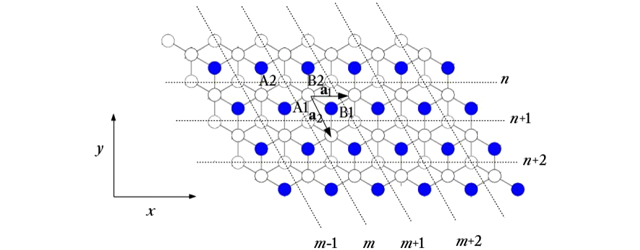
The conductivity of dual layers of graphene greatly depends on the states of carbon atoms at their edges; a property which could have important implications for information transmissions on quantum scales.
Made from 2D sheets of carbon atoms arranged in honeycomb lattices, graphene displays a wide array of properties regarding the conduction of heat and electricity. When two layers of graphene are stacked on top of each other to form a ‘bilayer’, these properties can become even more interesting. At the edges of these bilayers, for example, atoms can sometimes exist in an exotic state of matter referred to as the ‘quantum spin Hall’ (QSH) state, depending on the nature of the interaction between their spins and their motions, referred to as their ‘spin-orbit coupling’ (SOC). While the QSH state is allowed for ‘intrinsic’ SOC, it is destroyed by ‘Rashba’ SOC. In an article recently published, the authors showed that these two types of SOC are responsible for variations in the ways in which graphene bilayers conduct electricity.
P. Sinha, and S. Basu, Study of edge states and conductivity in spin-orbit coupled bilayer graphene, Eur. Phys. J. B 92, 207 (2019)
[Article]
Subcategories
- Highlights
- Vol. 41 No. 6 - Highlights
- Vol. 42 No. 3 - Highlights
- Vol. 41 No. 5 - Highlights
- Vol. 42 No. 1 - Highlights
- Vol. 42 No. 2 - Highlights
- Vol. 42 No. 4 - Highlights
- Vol. 42 No. 5 - Highlights
- Vol. 43 No.2 - Highlights
- Vol. 42 No. 6 - Highlights
- Vol. 43 No.1 - Highlights
- Vol. 43 No.3 - Highlights
- Vol. 43 No.4 - Highlights
- Vol. 43 No.5 - Highlights
- Vol. 43 No.6 - Highlights
- Vol. 44 No.1 - Highlights
- Vol. 44 No.2 - Highlights
- Vol. 44 No.3 - Highlights
- Vol. 44 No.4 - Highlights
- Vol. 44 No.5 - Highlights
- Vol. 45 No.1 - Highlights
- Vol. 45 No.2 - Highlights
- Vol. 45 No.3 - Highlights
- Vol. 45 No.4 - Highlights
- Vol. 45 No.5-6 - Highlights
- Vol. 46 No.1 - Highlights
- Vol. 46 No.2 - Highlights
- Vol. 46 No.3 - Highlights
- Vol. 46 No.4 - Highlights
- Vol. 46 No.5-6 - Highlights
- Vol. 47 No.1 - Highlights
- Vol. 47 No.2 - Highlights
- Vol. 47 No.3 - Highlights
- Vol. 47 No.5-6 - Highlights
- Vol. 48 No. 1 - Highlights
- Vol. 48 No. 2 - Highlights
- Vol. 48 No. 3 - Highlights
- Vol. 48 No.4 - Highlights
- Vol. 48 No.5-6 - Highlights
- Vol. 49 No.1 - Highlights
- Vol. 49 No.2 - Highlights
- Vol. 49 No.3 - Highlights
- Vol. 49 No. 4 - Highlights
- Vol. 49 No. 5-6 - Highlights
- Vol. 50 No. 1 - Highlights
- Vol. 50 No. 2 - Highlights
- Vol. 50 No. 3 - Highlights
- Vol. 50 No. 4 - Highlights
- Vol. 50 No. 5-6 - Highlights
- Vol. 51 No. 1 - Highlights
- Vol. 51 No. 2 - Highlights
- Vol. 51 No. 3 - Highlights
- Vol. 51 No. 4 - Highlights
- Vol. 51 No. 5 - Highlights
- Vol. 52 No. 1 - Highlights



